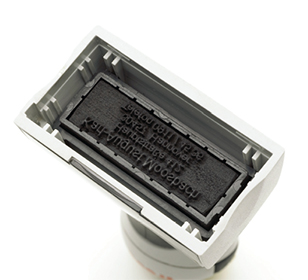Rubber stamp manufacturers increasingly are turning to laser engraving to boost efficiency and remain competitive.
Stamp Out the Competition
Lasers Can Give Rubber-Stamp Makers a Competitive Edge
By Josh Stephens, Trotec Laser
(Originally published in the July 2015 issue of Recognition Review.)
 Rubber stamp manufacturers increasingly are turning to laser engraving to boost efficiency and remain competitive.
Rubber stamp manufacturers increasingly are turning to laser engraving to boost efficiency and remain competitive.
Laser engraving streamlines rubber stamp manufacturing because it requires no postprocessing and fewer steps than photopolymer exposure or vulcanization. In addition to increased efficiency, laser engraving offers a level of precision, efficiency, consistency, and versatility that other technologies can’t.
COMMON PRACTICE ISN’T ALWAYS BETTER
While photopolymer exposure and vulcanization are two of the most common ways of producing rubber stamps, they require multiple steps. The photopolymer process requires the postexposure steps of washing and manually cutting out the stamps, which takes up a great deal of time, and when there is a high volume job, the amount of labor needed to keep up with the demand can significantly slow production.
Similarly, vulcanization requires dwell times and cure times during the phase in which the molds are created and when the stamps are created. With laser production, long waiting times are not necessary, because a single text plate can be produced in just a few minutes. Depending on order size and production volume, it is possible to produce individual stamps or an entire series with one run on the laser.
SIMPLE AND REPEATABLE
 Time and labor are important factors for any business to consider, and it can be difficult to train new personnel on complex equipment and multistep processes where a small mistake could cost the business a lot of money, either in wasted materials or time. You do not need highly skilled or specially trained personnel to operate a laser system. Graphics and text are engraved into the laser rubber directly and the text plate is cut out with a simple command. The laser can be operated by one user, saving in personnel costs.
Time and labor are important factors for any business to consider, and it can be difficult to train new personnel on complex equipment and multistep processes where a small mistake could cost the business a lot of money, either in wasted materials or time. You do not need highly skilled or specially trained personnel to operate a laser system. Graphics and text are engraved into the laser rubber directly and the text plate is cut out with a simple command. The laser can be operated by one user, saving in personnel costs.
When mass-producing stamps, the molds created through the vulcanization process can be helpful, yet those molds will not hold up over time after repeated use. In addition, the photopolymer process doesn’t have a way to easily repeat or re-create past jobs. When using a laser engraving and cutting system, past jobs can be saved and files are easily accessible with previous settings locked for reliable results. Producing the same stamp once or hundreds of times is easy, and the beam is always “laser sharp,” guaranteeing consistent results without having to continually create new molds or dies.
REDUCING CARBON FOOTPRINT
In a world where energy-efficient endeavors are becoming increasingly important, businesses have a responsibility to look at their current processes to evaluate their impact on the environment. Since laser technology creates the designs directly onto the material itself and does not require any expensive materials or consumables such as foils, molds or resin, they are incredibly eco-friendly, not to mention that the systems are extremely energy efficient.
 Some laser systems even come equipped with additional features that make rubber stamp production even easier and more comprehensive. For example, Trotec’s laser systems offer a Multi-Color Jet option which will ink the cartridge or stamp pad while simultaneously engraving the stamp text plate. All fifteen colors of the multicolor spectrum are already permanently installed in the Multi-Color Jet, so there is no need to retool. If you are interested in creating rubber stamps and already have a laser, read up on your laser’s special features for rubber stamp production or call the manufacturer for assistance.
Some laser systems even come equipped with additional features that make rubber stamp production even easier and more comprehensive. For example, Trotec’s laser systems offer a Multi-Color Jet option which will ink the cartridge or stamp pad while simultaneously engraving the stamp text plate. All fifteen colors of the multicolor spectrum are already permanently installed in the Multi-Color Jet, so there is no need to retool. If you are interested in creating rubber stamps and already have a laser, read up on your laser’s special features for rubber stamp production or call the manufacturer for assistance.
In addition to streamlining rubber stamp production, lasers can cut and engrave a variety of other materials, such as plastic, laminates, acrylic, paper, cardboard, leather, glass, and anodized aluminum, among many others. This helps to explain why the use of laser systems is on the rise. Extending a product line and increasing profitability have never been simpler.
Josh Stephens is a business development and applications expert with Trotec Laser. Contact him at sales@troteclaser.com. Trotec Laser manufactures state-of-the-art CO2 and fiber laser machines through 13 international sales locations. Visit www.troteclaser.com.